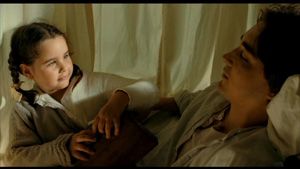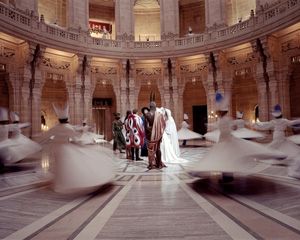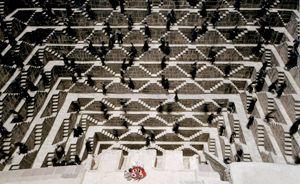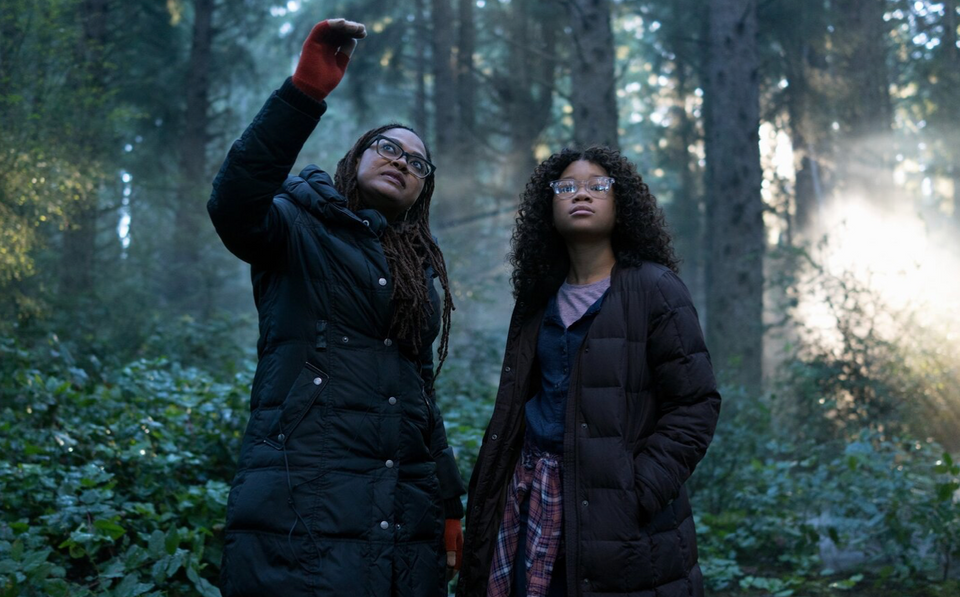* Warning: Minor spoilers.
“Here is the world. Beautiful and terrible things will happen. Don’t be afraid.”
-Frederick Buechner
Some movies are comfortable beginning cryptically, easing you into the story. But The Fall starts off with a bang. Black & white images flash slowly, set to a score of Beethoven’s Symphony No. 7: a head rising from beneath water; a cowboy; a feather floating; a coil of rope thrown downward; a dog yelping; a train with sunlit smoke like a pillar of cloud; men shouting; a dead horse pulled from the river on a levee. There are no voices, but in the style of a silent film, tragedy is written on everyone’s faces – a bad dream you shouldn’t forget.

The scene shifts to a Catholic hospital in 1915 Los Angeles, tinged with sleepy brown and green hues and natural light. Alexandria, age five, stands between two long rows of sick beds. One arm is broken, suspended midair in a cast. With her good arm, she carries a cigar box of things she likes. She wears a white gown, gray cardigan, black Mary Jane shoes, and her hair in pigtails. Her front teeth are missing – possibly the cutest little girl ever to appear onscreen. She looks at her fellow patients: a drowsy boy, a dejected girl leaning on a tray, and a crying baby tended to by a nurse. Wandering out of the children’s ward and into a room of adult invalids, she meets Roy Walker, a paralyzed stunt man with sad but kind eyes. “Did you know you’re named after Alexander the Great, who was the greatest warrior who ever lived?” he asks in a Southern drawl. Alexandria is curious, but timid of Roy’s malady.
When Alexandria is less than impressed with Roy’s tale, he spins a second epic to gain her trust. Reality becomes intertwined with story. He speaks of the Indian; Otta Benga – an ex-slave in a horned helmet; dynamite-happy Luigi; Darwin and his monkey, Wallace; and the masked bandit – all of whom possess a fiery hatred for Governor Odious. Roy paints this mythical band’s adventures in the spirit of an old Hollywood Western, but Alexandria’s mental image of “Indian” is of an East Indian in a green turban, instead of a Native American in feathers. We see Roy’s story through her imagination, flavored with the architecture of India.
Deserts, horses, and a palanquin caravan are shot with all the vastness of Lawrence of Arabia. Whirling dervishes spin in white and blue vestments on a cathedral floor. The “reality” scenes between Roy and Alexandria are quiet, private, and intimate. The story, and Roy’s motive in telling it, are elusive, and the “fantasy” scenes are full of otherworldly, painterly images – locations no one else could find.
The costumes are bright and vivid, as if sketched and painted right on the actor’s body (Darwin’s peacock-plumed coat and black top hat are particularly memorable). The stunning cinematography sweeps through tall spaces, perfectly framed and saturated with color. When I first watched this movie in the deep of night, it was the best kind of bedtime story, illuminating the darkness. The panoramic shots evoke desolation and frame the way in which the two convalescents connect.

In my favorite scene of the whole movie, Alexandria, new to the English language (both on- and off-screen), offers Roy a Communion wafer that she innocently swiped from Father Augustine.
Roy: Are you trying to save my soul?
Alexandria: Hmm?
Roy: Did you understand me?
Alexandria: (smiling) What you said?
Roy: I said, are you trying to save my soul? . . . The Eucharist, that thing you gave me, it saves your soul. . . . Are you worried about me?
Alexandria: What?
Roy: That little piece of bread. . . . It’s like strength.
Realizing that the chapel was located near the dispensary, and that Alexandria has gift for petty theft, Roy has an idea. His story becomes a lure – he would only continue if she delivered morphine pills; he intended to fall asleep forever.
The Fall is a surreal combination of their psyches, yet fused with realism. It’s a collage of countries, exotic architecture, and time periods. During the narration of Otta Benga’s history – a black slave in India who escaped his captors – the music is a slave song from the old South, sung by a Russian Orthodox choir. The intricate, mixed-up details of Alexandria’s imagination and whimsical associations can be easily missed if you aren’t paying attention. Governor Odious’s menacing black army looked like the hospital’s X-ray technicians in heavy, protective clothing; Luigi was the one-legged actor who came to visit Roy; Darwin was a hospital orderly; Alexandria’s deceased father was the bandit – Roy later replaced him as her mind conjured the story in grand, cinematic style, and as she befriended the paralytic. Even the props on set are a scavenger hunt of clues to the story.

The DVD includes some fascinating special features. I was astounded by writer-director Tarsem’s (The Cell) tireless dedication to his art. Making any movie is hard work, but I could not believe the lengths that Tarsem went to in order to birth his vision of The Fall. After a failed relationship and unwilling financiers, he sold everything but his house to fund the movie. As Tarsem put it, “It had to be made by somebody at a mad junction in his life.”
He trekked around 24 countries for 16 years scouting locations, saving time and money by doubling his efforts – he would only film TV commercials in locations suited for The Fall. In a New York Times article, David Fincher (who presented the movie along with Spike Jonze) said that Tarsem “told me when he was going in that ‘my production value is going to be the earth; I’m going to use the entire world as my backdrop.'” He traveled to the Great Wall of China and Argentina for a single shot, and with a friend’s help, snuck into Hagia Sophia early one morning to film for just ten minutes. He even staked out dangerous locations, bribing a contact in order to film in front of a beautiful mosque which has guards known for stoning unwanted visitors.
There are few special effects here; when a butterfly segues to a remote island, or a priest’s face to mountainous desert, it is only Tarsem’s recognition of similar shapes and film layered upon film. That elephant is actually swimming under blue-green water. What looks to be a digital homage to an M.C. Escher piece is actually black-clad actors performing symmetrical choreography in an old well of interlocking stairs. When the bandit and his companions spy a blue city below, it is a Brahman town, the inhabitants only allowed to paint their walls a certain shade of blue – just “the right amount of realism,” said Tarsem in the DVD commentary.
This realism was also crucial in the performances, so as in the making of The Fall, Tarsem took his time with auditions. After a weary search for his child-muse, he found Catinca Untaru from Romania. He knew that in a few years, she’d lose her naturalism and innocence. He admired Lee Pace’s (Pushing Daisies) performance in Soldier’s Girl, but he was so convincing as a transvestite that Tarsem had to confirm his leading man was indeed male. With the two most crucial actors in place, Tarsem set to filming right away, shooting the “reality” scenes sequentially in a South African hospital – Untaru’s missing front teeth grew in during these sequences – and the “fantasy” scenes in India. To further enhance Untaru’s authenticity, Pace pretended he was paralyzed, and that his name was “Roy.” This unorthodox method worked. Untaru drew pictures for Pace and took care of him, much like their film personas, and Pace grew despondent while stuck in bed and a wheelchair.
Aside from its fantastical realism and visual opulence, The Fall‘s overlapping stories mirror reality: each of our stories are part of a bigger story. Storytellers and art-makers should tell the truth; listeners and patrons must have childlike faith, believing in what we cannot see.

Alexandria grows frustrated as Roy’s emotions hinder his storytelling. She says, “You always stop at the same part, when it’s very beautiful and interesting.” And in a heart-wrenching scene near the end of the film, Alexandria begs Roy not to destroy the story.
Roy: (crying) There’s no happy ending with me. . . . It’s my story.
Alexandria: (also crying) Mine, too. . . . You are making this up.
Roy: No, I’m not.
But he was; it is possible for a work of fiction to be a true story. Like any good tale, Roy’s was collective, connecting the storyteller, the listener, and all of reality; it wasn’t just Roy’s story, because it had become Alexandria’s, too.
As storytellers, and human beings, it is sometimes a fearful undertaking to believe, to go where our story leads. It takes courage to listen, to hope, and to fight. Their story ends with redemptive sorrow, so rich with detail and emotion that you want to watch it again and again – happy, but not trite. One pleads with Alexandria for Roy to not be fearful and selfish, but to paint the truth.
In fact, I feel the urge to replay the whole movie over and over – truth is the same yesterday, today, and forever. Thanks to Tarsem, who, like Roy, fought with courage to make his story truthful and breathtakingly beautiful, The Fall resonates with humanity.



